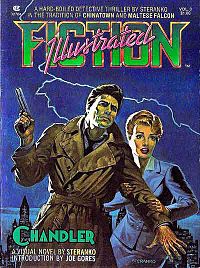- Chandler: Red Tide
-
Chandler: Red Tide 
Chandler: Red Tide (1976)
Painted cover by writer-artist Jim SterankoAuthor(s) Jim Steranko Illustrator Jim Steranko Cover artist Jim Steranko Country United States Language English Series Fiction Illustrated Vol. 3 Genre(s) Graphic Novel, Historical Fiction Publisher Pyramid Books Publication date 1976 Media type Print (paperback) Chandler: Red Tide is a 1976 illustrated novel, an early form of graphic novel, by writer-artist Jim Steranko.
The digest-sized book combines typeset text with two same-sized illustrations per page, utilizing no word balloons or other traditional comics text conventions. A hard-boiled detective novel in the film noir style, its protagonist is a private detective named Chandler (an homage to author Raymond Chandler) who is hired by a man who claims to have been poisoned by the same people responsible for a notorious gangland slaying. As Chandler tracks down witnesses, each begins to turn up dead.
Contents
Publication history
 Newsstand edition, distributed by Curtis Circulation (see logo, top left), stressing Fiction Illustrated series. Note "Vol. 3" at top right.
Newsstand edition, distributed by Curtis Circulation (see logo, top left), stressing Fiction Illustrated series. Note "Vol. 3" at top right.
Packaged by Byron Preiss Visual Publications and published by Pyramid Books,[1] under vice-president Norman Goldfind,[2] in 1976, Chandler was written, drawn, and colored by veteran comics creator Jim Steranko, who also provided the cover painting and oversaw production, including design and typography.[citation needed] There is an introduction by crime novelist and former San Francisco private detective Joe Gores, and a foreword by Preiss. The original cover price was one dollar.
Preiss said the book was created to retail at American newsstands alongside hundreds of other paperback offerings".[3] The mass-market edition (ISBN 0-515-04078-9), which Preiss said had a "50,000+ press run",[3] was supplemented by a 750-copy limited edition with a tipped-in signature plate.[citation needed] The latter edition was double the dimensions of the newsstand edition.[3]
The third in a series from the publisher, it is also known as Fiction Illustrated Vol. 3. (See image at left.)
Steranko in 1978 recalled the project's genesis:
Chandler was a fill-in book. That particular number of [the] Fiction Illustrated [series] was to have been Ralph Reese's Sherlock Holmes book [eventually published as Fiction Illustrated #4 — Son of Sherlock Holmes (1977)]. Ralph had worked on it for a year, and Byron realized ... that the book couldn't get out in time. He asked me if I would do a book to replace it. There are two men you never ask to fill in on a late deadline: Neal Adams and myself. We're both overcommitted. Byron's a good friend and I tried to do what I could for him, so I said I would do this book. It was produced in 2½ months where it should have taken at least six months to do. It was my first visual novel, and it was a major project.[4]
He elsewhere said that in creating the book he used golden sectioning, "a mathematical formula to arrange elements in a unified structure, to create an image-to-text relationship that readers would be very comfortable with. The text on any given page related only to that page".[5]
Steranko, who retained rights to the character, was then assigned to create a 12-page "Chandler" story for Penthouse magazine, working with executive editor Art Cooper. When Cooper departed Penthouse, the project was canceled and Steranko was paid a kill fee.[6]
Dark Horse Comics had planned to publish a revised edition of Chandler: Red Tide in December 1999, with revamped and more hardboiled art and text by Steranko,[7] but this did not see fruition. Dark Horse Presents vol. 3, #3 (Aug. 2011) included a 13-page Chapter 1 of Red Tide.[8]
Reception
 Print featuring the title character. Art by Jim Steranko.
Print featuring the title character. Art by Jim Steranko.
Chandler: Red Tide did not meet sales expectations, with Steranko recalling in 2003 that, "When the book appeared it was not embraced by the comic-book community because it didn't have word balloons or captions. Believe it or not, they found that shocking!"[5] In 1978, shortly after the book's publication, he said, "I was disappointed in Pyramid's distribution and promotion of it. ... They did a major mailing on it, but there was more that can be done".[4]
Illustrated-novel format
Chandler: Red Tide is similar to Harold Foster's comic strip Prince Valiant in that the narrative is carried by a combination of graphics and text blocks without word balloons. Critics are divided on whether it is a true graphic novel, its advocates noting that its images are integral to the story rather than merely illustrating the text.[citation needed] Steranko used the term "graphic novel" in his introduction, though it was labeled "a visual novel" on the cover.
References
- ^ The back cover reads: "A Pyramid publication produced by Byron Preiss Visual Publications"
- ^ Ashley, Mike. Gateways to Forever: The Story of the Science-Fiction Magazines, 1970–1980, (Liverpool University Press - Liverpool Science Fiction Texts & Studies, 2007), p.323
- ^ a b c Preiss, Byron "Eisner or Steranko? Check the Facts" (op-ed), ComiCon.com: The Pulse, July 22, 2003. WebCitation archive.
- ^ a b Burchett and Mantels, p. 12
- ^ a b Archive of Epstein, Daniel Robert, "The First Graphic Novel? Steranko's Take", Newsarama, July 14, 2003.
- ^ Burchett, Rick, and Ed. Mantels, "Whizzard Talks to Steranko", Whizzard vol. 2, #11 [issue #16] (Summer 1978; published by Marty Klug, 5730 Chatport Road, St. Louis, Missouri), p. 13
- ^ Smith, Kevin Burton. "Chandler", ThrillingDetective.com, n.d. WebCitation archive.
- ^ Dark Horse Presents vol. 3, #3 at the Grand Comics Database
External links
- The Drawings of Steranko: '"Red Tide (fan site)
Categories:- 1976 books
- American graphic novels
Wikimedia Foundation. 2010.
